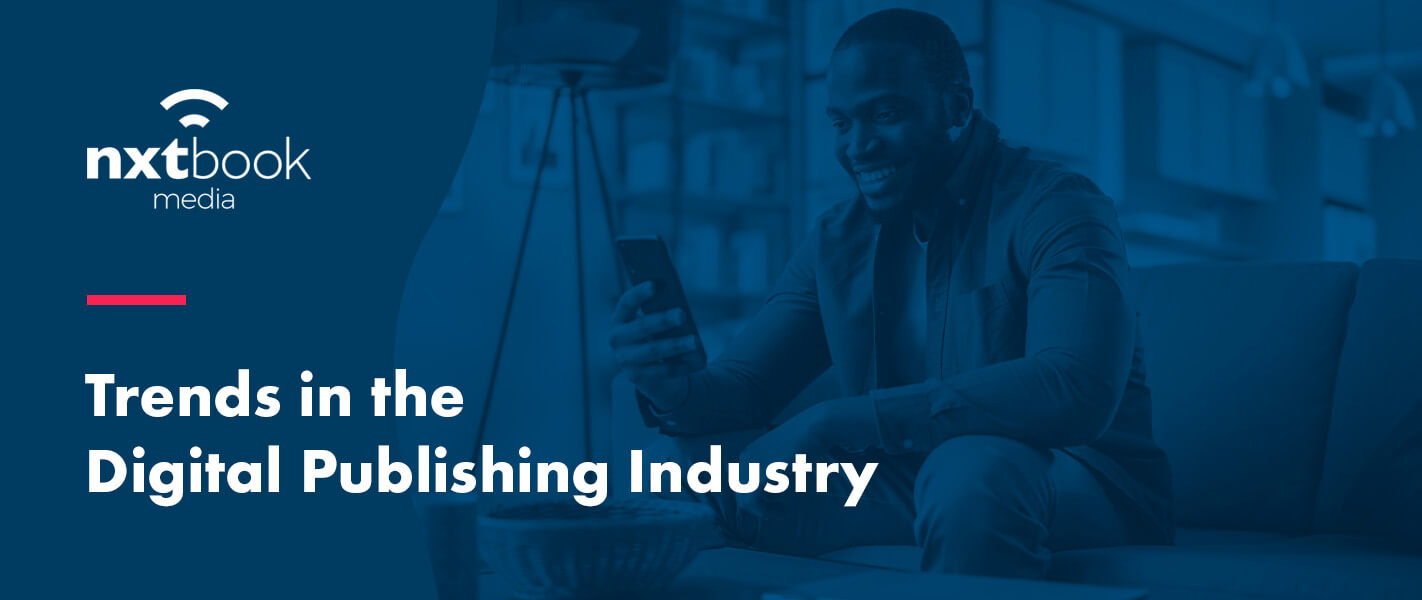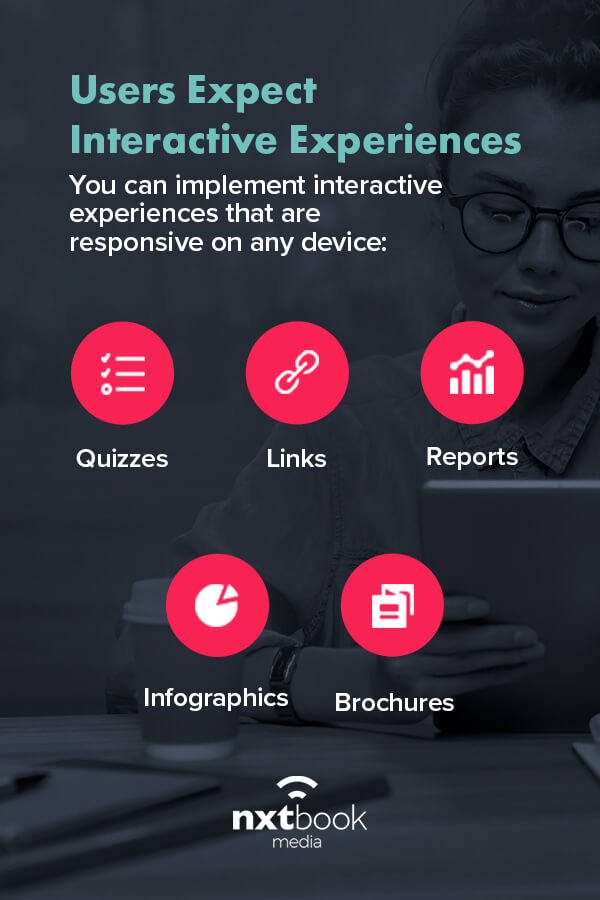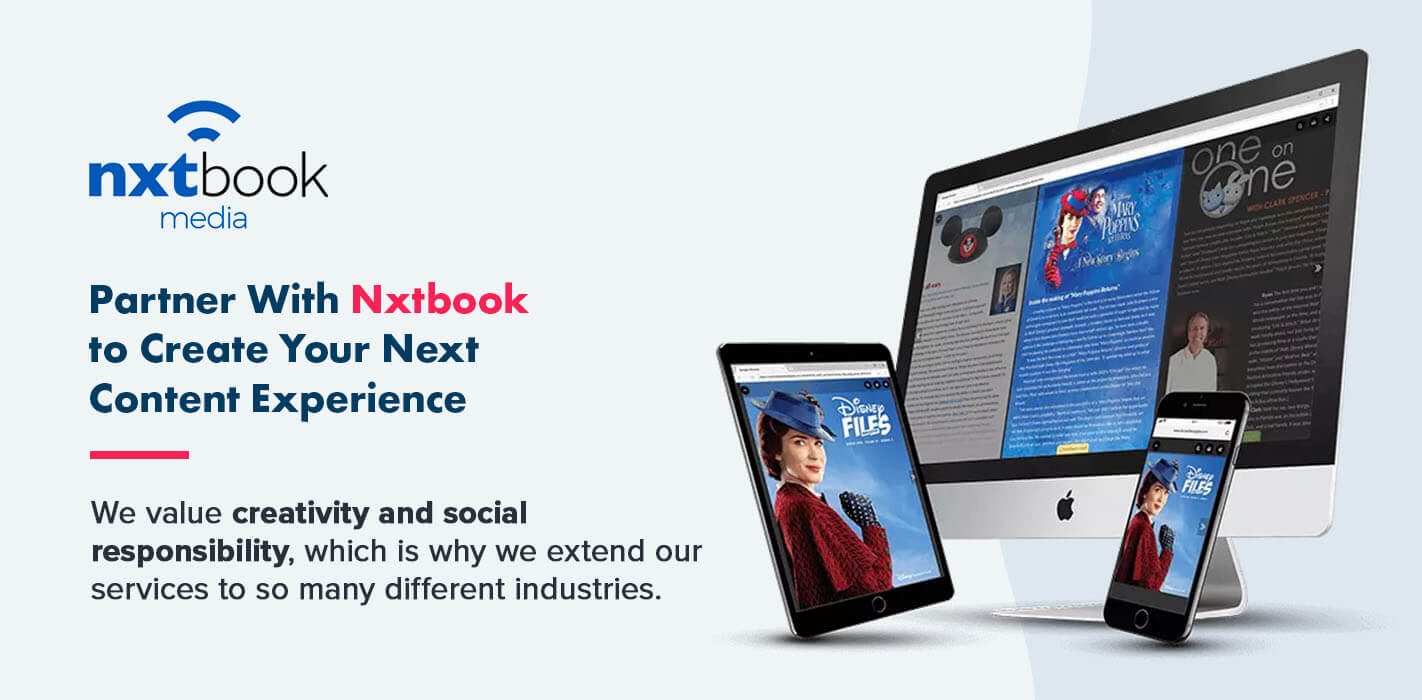Trends in the Digital Publishing Industry

Written by Matt Berringer
January 1, 2022

The state of digital publishing is constantly fluctuating and accommodating to user demand. As new technologies develop, customer expectations expand, and the cycle continues. It is safe to say that traditional media and content, such as print publishing, may no longer be mobile users’ preference. Therefore, it is necessary for the global publishing market and individual content publishers to create room for solutions that improve the consumer experience. These solutions must implement new practices that digitalize content in a secure, interactive and immersive way.
Adapting to digital distribution and engaging readers can help publishers facilitate growth and enhance customer satisfaction. Luckily, digital publishers can utilize many new tools, trends, features and services to improve their reader engagement. Here are some digital publishing trends to keep in mind when considering your online content.
A New Market Is Emerging
All brands and businesses exist within a competitive market, but this is especially true for those online. Print publications are slowly being overtaken by digital publishers who offer their users limitless capabilities. While convenience is a given trait for most websites, you should also display the benefits of your products, services, and content. In addition, digital publishers must find a balance between accessibility, searchability, and readability while keeping distribution costs low.
Offline Spending Is Cratering
In the age of advanced technology and constant digital usage, offline spending has decreased while online e-commerce convenience has taken over. It’s no secret that online spending has become even more popular since the COVID-19 pandemic. It is perhaps more practical than ever for consumers to fulfill their needs through online platforms and services. Customers often know which brands and industries are pushing the envelope to bring them updated trends and usability. Users want and expect effortless online entertainment, media, shopping and content.
For digital publishers, this means you must update platforms and design to meet current standards. Traditional publishing strategies are no longer as worthwhile as they used to be because print media, such as physical newspapers, have decreased in value and popularity. With growing expectations and demands for online spending, digital publishers must incorporate flexibility with updated content. Print publishing methods are often slower, more costly, and a hassle to distribute.
Digital publishing allows you to activate online content globally, reaching a wider audience and bringing your readers what they want to see. Traditional media also limits a reader’s capability to obtain content from any location, whereas online media is much more user-friendly. A 2021 survey stated that books were among the top choices for products consumers prefer to purchase online rather than offline.
With this information, digital publishers know there is a large market available for online readers. All you have to do is develop new options to fulfill consumer desire.
Audience Segmentation Is Leading to Higher ROI
Creating a personalized online experience for users requires considering the audience’s interests and needs. For example, providing relevant offers and marketing tactics can help narrow down your audience to the visitor demographic you aim to serve. This process is part of audience segmentation. When improving your digital publishing market size and strategies, it’s important to obtain background information about your consumers to further enhance your ability to attract them. This method enables you to expand your customer base while tailoring your message to meet a specific need.
Increasing your reach is one way to increase digital publishing revenue. These digital revenue opportunities can lead to higher returns on investment (ROI) for your business.
For digital publishing platforms, especially those creating longer readable content, finding new ways to let your consumers access that content is essential. For example, improving your platform with new features that enhance readability or user experience is a great way to stand out and adapt to market shifts. Analyzing and measuring consumer data can be done by identifying your audience’s:
- Social media engagement.
- Interests, motivations and lifestyles.
- Behaviors and decisions.
- Purchasing or reading habits.
Once you have determined your audience and what attracts them through segmentation, you can test out new strategies and adjust your digital publishing tools accordingly. A better understanding of consumers’ preferences for digital content can facilitate more effective advertisements, promotion strategy, product development and strategic thinking.

Digital Marketing Budgets Are Increasing
Along with consistent increases in digital use, there is also an accommodating increase in marketing and advertising budgets. Digital ad spending increased by 12.2% in 2020, and with the steady escalation of online consumerism, we can expect those numbers to rise each year. Digital publishers can take advantage of this new age by implementing trends that will become long-time standards. Developing new advertising methods to improve audience interaction with your marketing strategies is a great way to complement an increased budget.
Focusing on popular forms of online content such as e-books, e-magazines and newspapers can help digital publishers strengthen their approach to growing their business. U.S. e-book publishing revenue is expected to grow from $6.07 billion in 2021 to $6.95 billion in 2025. Overall, digital publishing anticipates continuous revenue growth, reaching about $35 billion by 2025. These statistics project a profitable future for digital publishers as digital consumerism trends upwards.
An increased online presence creates more room for potential customers and enables more digital publishing market share opportunities. Compared to traditional means of publishing, online content accessible through a mobile device, such as a smartphone, tablet or laptop, aligns with this industry revolution. Digital publishers must take advantage of increased budgets and apply the best publishing platforms to drive revenue, improve content performance, and strengthen their market share.
Customer Expectations Are Growing
Without the right tools, creating and implementing a new digital strategy to meet consumer needs can be challenging. Spending money, time, effort and resources attempting to meet short-term content ideas and trends can have a detrimental impact. Digital publishers should consider a few aspects of customer expectations before shifting or diversifying their traditional publishing.
Users Expect Interactive Experiences
Online shopping and e-commerce have skyrocketed over the years, and
the best digital publishing trends will align with that growth.
Consider new ways to attract customers and maintain an immersive,
entertaining experience.
Younger generations especially may expect faster-loading content that is easier to navigate. When your publishing platform allows easier access, it can increase
customer loyalty. Online viewing should be easy and all about your
customers.
Users familiar with technology trends and changes can influence the digital market landscape as they decide which features improve their interactions with content. An interactive experience is essential for encouraging visitors to engage with your content and learn more about it. Customers are no longer willing to waste time on a website with boring, slow-loading PDFs and few opportunities for engagement.

Digital publishing uses intuitive, creative tools to reach a broad range of readers and produce an inviting environment that inspires action. As a digital publisher, you can implement interactive experiences that are responsive on any device, such as:
- Quizzes.
- Links.
- Reports.
- Infographics.
- Brochures.
Any features that get your users to click or tap on various content areas create an interactive experience. Whether you want your consumers to purchase, learn, read, download or share your content, interactive features let them control what they want to view. This interactivity makes your content more enjoyable and increases the likelihood of readers coming back to see what else you have to offer.
Multi-Platform Marketing Is Here
Managing customer expectations is easier when you have access to multiple platforms that enable feedback and consumer information. Multi-platform marketing is valuable for reaching your audience through many different sources and pathways. These sources could include emails, newsletters, downloadable content, social media ads and promotional campaigns. Marketing your content and digital publishing tools on several platforms can increase your audience and keep your business in line with social media and publishing trends.
Tracking your customer’s interests can also help create solutions to engagement challenges. Customer data allows you to gauge more efficient ways to reach your audiences, such as implementing the most popular trends or influences. Trust also plays a key role in satisfying customer appetite for responsive and captivating content. Your users want to know that they will have a good experience, from viewing graphics to scrolling to using quick links. Building your reputation through consistent, recognizable marketing tools is an effective way to upgrade your user experience.
With digital publishing platform comparison, you can find examples to determine which digital-friendly formats will help you offer online services that make the required impact. Your online content is not limited to one source of publishing. Digital newspapers, catalogs, journals, reports, and magazines are just a few of the outlets you can explore.
Producing content that satisfies users requires an intense dedication of time and resources. Marketing your business effectively can make that effort worthwhile.
Customization Is Expected
Customization for user experience is just as important as interactive features. Create digital newsletters, graphics and catalogs that bring a sense of personalization to your consumer audience. Personal information often comes from readers’ locations, reading history and preferences. Visitors rely on online interactions that deliver relevant personalization and efficiency. If you are not already on board with customized content, consider that seven out of 10 online publishers work to create and deliver personalized content to their users.

Digital publishers who ignore visitor data may have a more difficult time implementing tailor-made content for their audience. You can use several customization options to strengthen your digital publishing market penetration, including:
- Videos
- Branding
- Subscription emails
- Animations
- Slideshows
These formats can help clarify what you offer your customers and how it will benefit them. Customization is the perfect opportunity to showcase why your content and platform are better than your competitor’s at meeting the needs of your community. Utilize best practices such as SEO to further a relationship with readers and boost traffic to your website or other content formats. Digital publishers can also take advantage of design tools to emphasize high-quality content.
As a digital publisher, you should also consider publishing tools and resources to enhance your customization for videos, visuals and graphic design. Another way to apply customization is by dialing down any aspects of your marketing that appear to oversell your content insincerely. Let your work speak for itself and frame your marketing to educate or entertain your readers through their needs and interests.
New Tools Are on the Horizon
Adapting to new digital publishing industry trends means learning about the different options to improve your content. Digital publishers can benefit from new tools and features that reflect their customer response. Publishing content digitally also provides an advantage for easily editing or updating any mistakes, factual errors or negative impacts to your business. With so many tools at your disposal, you can begin to find the right solutions for your publishing services.
AI in Publishing
AI-generated content, software and web services have grown rapidly over the years. While digital publishers work hard to develop engaging, high-quality and original content, you may not always keep up with fast-moving trends. AI technology compiles data and insights that provide digital publishers with recommendations to enhance the personalized experience. Just as with any valuable visitor information, these recommendations can assist in creating more relevant, optimized content.
AI can also help produce more valuable content by recognizing trending stories, information and preferences. We know that analyzing user data is important for appealing to customers and generating interactive services, but what about more detailed data? Customer profiles automatically update a user’s interaction with a website or other online content. These profiles help enhance customer satisfaction and create appealing ads or marketing strategies that users will want to see.
Digital publishers can use AI in information technology, finance, marketing and customer service departments. This well-rounded method of upgrading operations and reducing disruptions can improve accessibility and create an enhanced user experience. AI technology can also help produce content translations, automated formatting, chatbots, SEO and automated text analysis, all useful tools for digital publishers. For academic publishers, AI can support verified, peer-reviewed research that is ensured for innovation and accuracy.
AI can help with the workflow for any digital publishing landscape by reducing costs and time.
First-Party Data Collection Tools
To analyze user data, you first have to know how to collect it. Digital publishers can implement first-party data collection tools, which offer many different ways to access customer and visitor information. First-party data is personal data assembled from a business’s consumers, customers or visitors. This information is often gathered directly from user input or online fields such as:
- Search engine analytics
- Mobile apps
- Contact information
- Mobile websites
- Web engagement
- Purchases
- Surveys
- Emails
- Downloads
First-party data is often more straightforward, reliable and ethical than second- or third-party data, which is usually purchased from a provider. First-party data is also typically more transparent and accurate because users give it to a company directly and willingly, making it a preferred marketing strategy. With this information, digital publishers can improve marketing efforts, website performance and other digital tools and features. Data collection enables publishers to deepen their understanding of their audience, reduce misinformation and amplify reader experience.
As a digital publisher, you can use this data to anticipate reactions from their customers and project overall content performance. Dialogue is more clearly defined when you know your consumer’s point of view, so implementing a data collection tool will surely benefit your digital experience.
Partner With Nxtbook to Create Your Next Content Experience
If you’re a digital publisher, you’ll want to invest in solutions that create significant impacts on the services that you offer. With Nxtbook Media, you can increase engagement while meeting the growing needs of the publishing industry.
We are an experienced and flexible team of individuals dedicated to providing you with customizable services, adaptable technology, and security for your digital efforts.
Digital publishers can rely on Nxtbook Media to offer detailed insight for developing updated, high-quality, and premium content that your readers want to see. Ditch the old, unresponsive publishing methods and increase interaction with our production services. We can discuss analytics and strategies that deliver results and empower you to produce engaging content consistently.
We want to assist you with any issues or challenges to improve the customer experience for your business and help you share your content with the world. Our most popular products, nxtbook and PageRaft are readily available to impress your audience. Download our ultimate guide to digital publishing for additional information. You can also request a demo or contact us for a consultation to find the right solution for your project.
